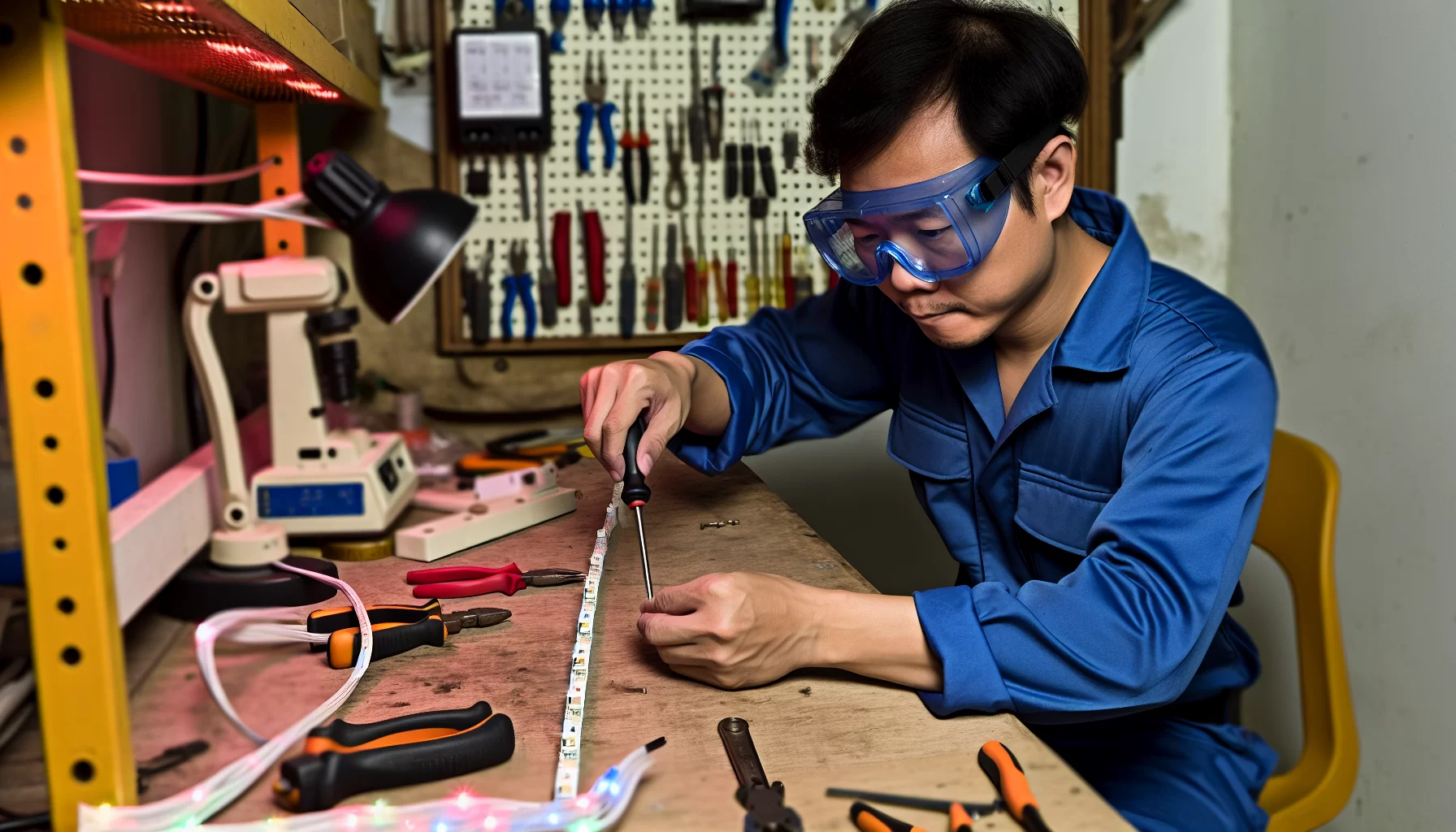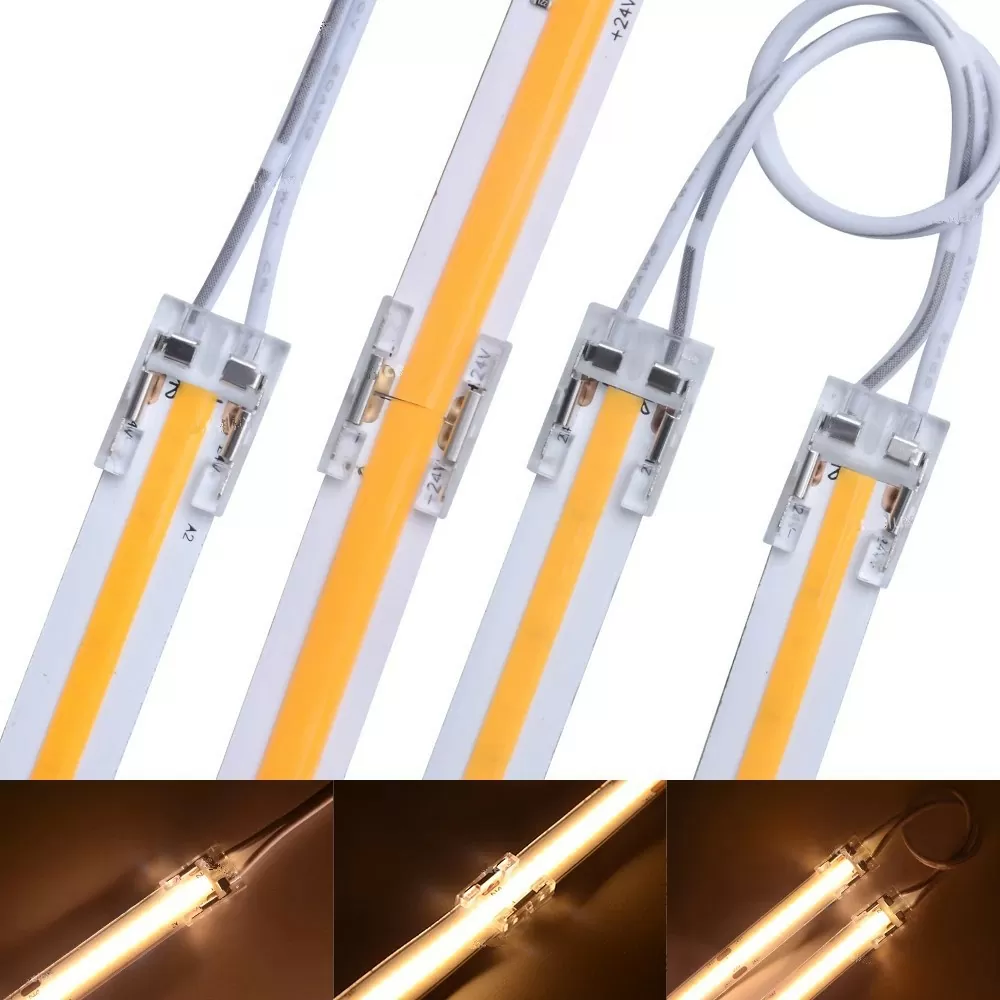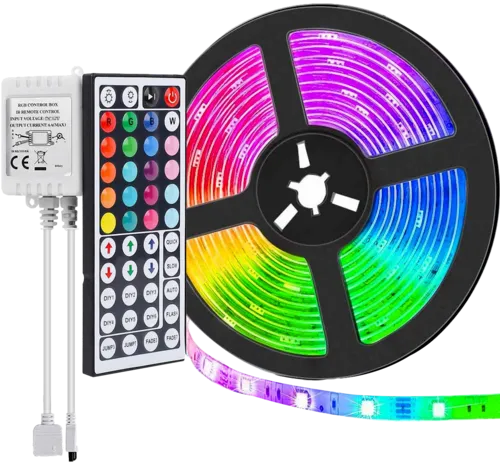Is it safe to use LED strip lights? This question is on the minds of many looking to enhance their spaces with efficient and versatile lighting. Safety is paramount, and the good news is that LED strip lights are designed with low heat output, low voltage, and other built-in safety features. In this concise guide, we will uncover the essentials of LED strip light safety, address common concerns, and provide practical tips to ensure you use these lights securely. Read on to illuminate the truth about LED strip light safety, without unnecessary complexity or worry.
Besen is top leader of led strip manufacturer in China, they supply safe and best quality with varies type rope lights.
Key Takeaways
LED strip lights are generally safe due to low heat generation, energy efficiency, and low voltage operation, but excessive blue light can cause eye strain; mitigating this involves using warmer colors and adjusting brightness.
Safety and longevity of LED strip lights rely on high-quality products with certifications like UL Listed, proper installation to avoid hazards such as electrical shorts, and regular maintenance to identify potential issues.
While LED strip lights have a minimal fire risk, proper precautions, such as using the correct power source and avoiding circuit overload, are crucial to mitigating risks like fire hazards, eye strain from blue light, and overheating.
Understanding the Safety of LED Strip Lights
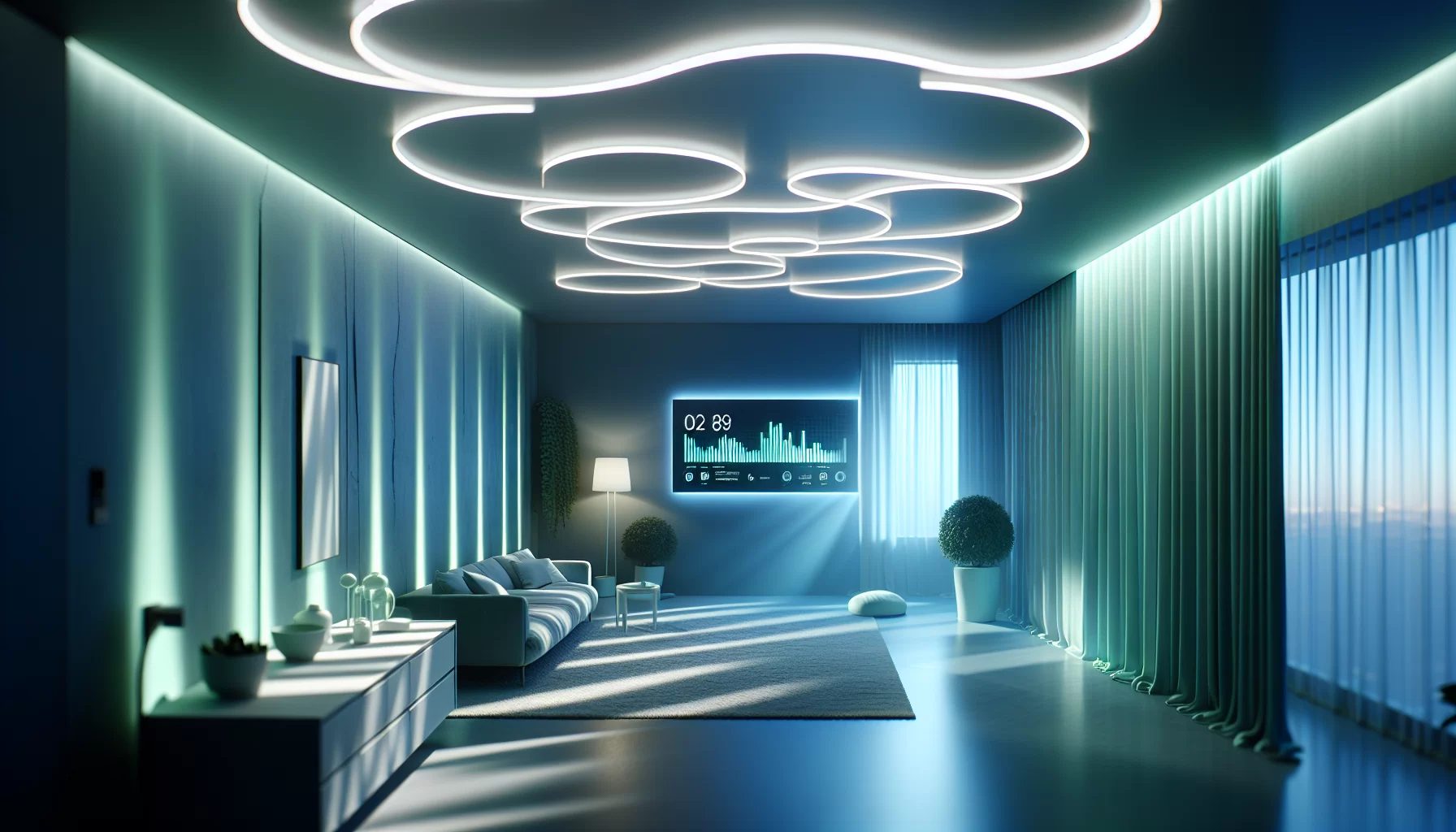
At the heart of their popularity, LED strip lights are known for their inherent safety features. Their energy-efficient nature, minimal heat generation, and low voltage collectively contribute to their safety for outdoor use. Indeed, most LED strip lights can be left on for extended periods without safety concerns, thanks to their design that minimizes the risk of overheating.
However, bear in mind that LED strip lights can cause eye strain due to excessive blue light exposure. This can be alleviated by adjusting the brightness, using warmer colors, and ensuring the lights are not positioned directly in the line of sight. Before examining these factors, it’s beneficial to comprehend the fundamental safety characteristics of LED strip lights.
Low Heat Generation
One of key reasons for the significant advantages of LED strip lights over traditional light bulbs is their low heat generation. LED strip lights maintain lower temperatures by operating more energy efficiently, avoiding the production of excessive heat, a factor contributing to the higher temperatures in traditional bulbs.
LED strip lights typically operate at temperatures ranging from 25°C to 55°C, a range that is generally considered safe and does not present a significant risk of burns or fire hazards. Materials like aluminium, known for its thermal conductivity, are often used in LED strip lights to facilitate efficient heat transfer, minimizing the risk of the hot side lights catching fire.
Energy Efficiency
LED strip lights are champions of energy efficiency, offering greater illumination, producing reduced heat, and incurring notably lower costs than traditional lights. The efficiency of LED lights ranges from 30% to 50%, with a smaller portion of the energy being converted into heat.
In essence, LED strip lights:
Convert the majority of the energy they consume into light energy
Significantly reduce energy costs
Minimize carbon footprint and greenhouse gas emissions
Result in lower electricity bills
Contribute to a reduced environmental impact.
Low Voltage
The low voltage of LED strip lights, usually 12V, enhances their safety compared to lighting options with higher voltage. It reduces the risk of shock and is generally more suitable for residential and commercial use. This low voltage operation, along with the use of low voltage DC power, results in:
Safer operation
Diminished risks
Increased efficiency
Flexibility in installation
However, be aware that overpowering LED strip lights can lead to voltage drop, which can cause dimming or malfunction. But, the risk of fire is typically minimal, especially when using high-quality LED strip lights.
Interestingly, the 24V LED system is typically considered safer due to its lower current draw compared to the 12V system for the same power level, reducing the risk of electrical issues and extending the effective length of the strip.
Factors Affecting LED Strip Light Safety
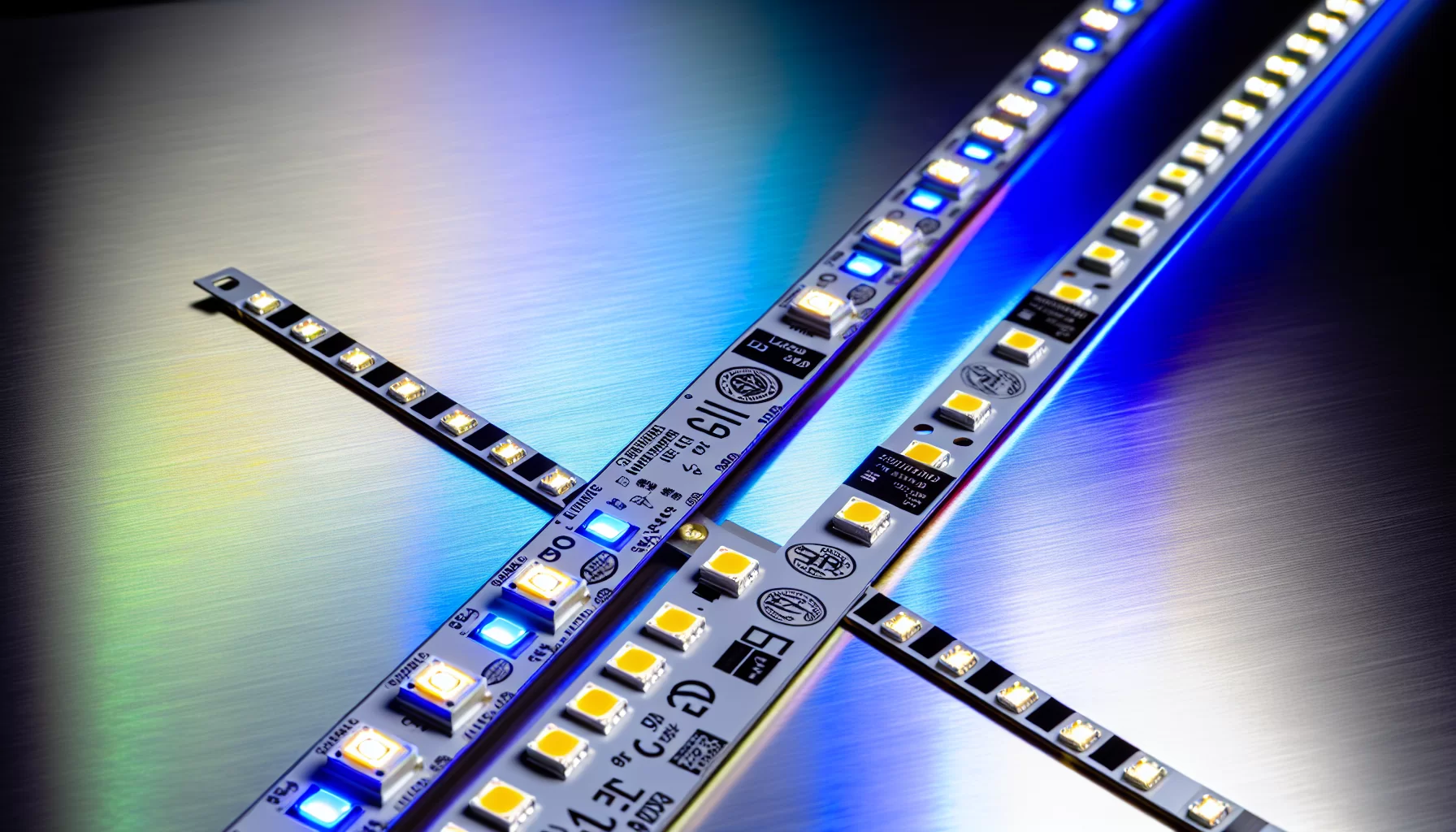
While the inherent safety features of LED strip lights make them a reliable choice, several factors can affect their safety. These include the quality of the LED strips, proper installation, and regular maintenance and inspection.
Investing in high-quality LED strip lights, such as led tape, provides durable adhesive backing, enduring LED units, and dependable copper wiring and connectors. Moreover, professional installation of quality led strips can help avoid potential hazards such as poor heat dissipation, unreliable adhesion, and premature detachment, thus ensuring the safety and longevity of the lights.
Furthermore, regular inspections are crucial as they aid in the identification and resolution of any potential safety concerns.
Quality of LED Strips
The safety of LED strip lights significantly depends on investing in high-quality products. These lights provide durable backing, enduring LED units, and dependable copper wiring and connectors.
To ensure better safety and durability, it is advisable to seek out products that hold safety certifications such as UL Listed or ETL certification, which guarantees that the LED strip light’s power supply and wiring are engineered to mitigate overheating and fire risks. In essence, a high-quality LED strip light provides more than just illumination; it offers peace of mind.
Proper Installation
Ensuring the safety of LED strip lights hinges on their proper installation. The appropriate installation, encompassing the use of the right power supply and wiring, has the potential to avert potential dangers such as electrical shorts and overheating, and extend the lifespan of the LED strip lights.
To ensure the safe installation of LED strip lights, follow these steps:
Clean and dry the installation surface.
Align the strip lights and firmly press the adhesive to the target surface.
Connect the power supply.
Verify the functionality of the lights to ensure they are working properly.
An inadequate installation can result in premature failure of LEDs and potential electrical hazards that could lead to damage or safety risks.
Maintenance and Inspection
Routine maintenance and inspection play a vital role in safeguarding the LED strip lights. Frequent inspections can help identify potential safety concerns such common issues such as:
overheating
power cord failures
loose connections
water damage
This is particularly important when a large number of lights are connected.
LED strip lights should be regularly inspected for indications of wear, damage, or exposed components to uphold safety standards. This way, potential issues can be addressed promptly, ensuring the continued safe operation of your LED strip lights.
Potential LED Strip Light Risks and How to Mitigate Them
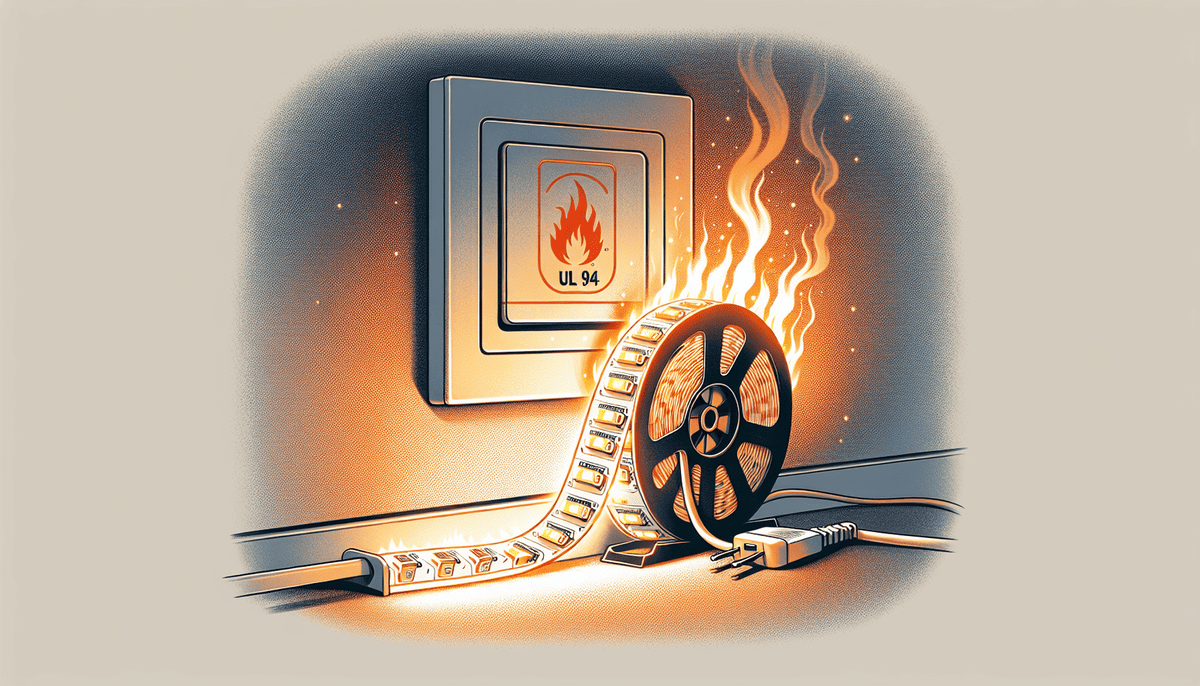
Despite their many safety features, LED strip lights do come with certain potential risks. These include fire hazards, eye strain due to excessive blue light exposure, and overheating. However, with proper precautions, these risks can be effectively mitigated.
Keep in mind that due to their low voltage characteristics, LED strip lights pose a minimal potential fire hazard. However, to mitigate this risk, the following steps are recommended:
Use the correct power source for your LED strip lights.
Avoid circuit overload by not exceeding the maximum wattage or current rating of your power supply.
Select high-quality LED strip lights from reliable manufacturers.
By following these recommendations, you can ensure the safe use of LED strip lights and minimize the risk of fire.
Fire Risk
Fire risk is a common concern when it comes to any electrical appliance. However, LED strip lights have a minimal fire risk due to their low voltage characteristics. The potential fire hazard linked to LED strip lights is typically minimal given their low voltage characteristics.
Furthermore, safety certifications such as the UL 94 flammability rating can provide additional peace of mind. This rating signifies that the LED strip lights are resistant to igniting and can extinguish quickly once lit, thereby enhancing their safety in various environments. Similarly, class 2 power supplies, equipped with built-in protection features such as:
over-current protection
over-temperature protection
short-circuit protection
open-circuit safeguards
Aid in reducing fire risks and preventing situations where objects may catch fire.
Eye Strain and Blue Light Exposure
While LED strip lights emit beautiful and vibrant light, one of the potential hazards linked to them is the possibility of causing eye strain due to excessive blue light exposure. This can result in symptoms such as eyestrain, blurred vision, and in severe instances, eye damage.
To mitigate this, consider the following:
Adjust the brightness of the LED strip lights
Use warmer colors instead of cool white lights
Position the lights away from direct line of sight
Properly position the LED strip lights to reduce blue light exposure and alleviate eye strain.
Overheating and Heat Dissipation
Overheating is another potential risk associated with using LED and strip lights, especially if they are not installed in areas with adequate ventilation. Overheating can notably diminish the lifespan of LED strip lights and induce a temporary decline in light output, thereby impacting their performance.
Therefore, installing LED strip lights in well-ventilated areas to allow for efficient heat dissipation is recommended. Additionally, heat sinks play a crucial role in dissipating the heat generated from the LED strip and preventing overheating by dispersing it into the air.
Safe Use of LED Strip Lights in Different Areas of Your Home
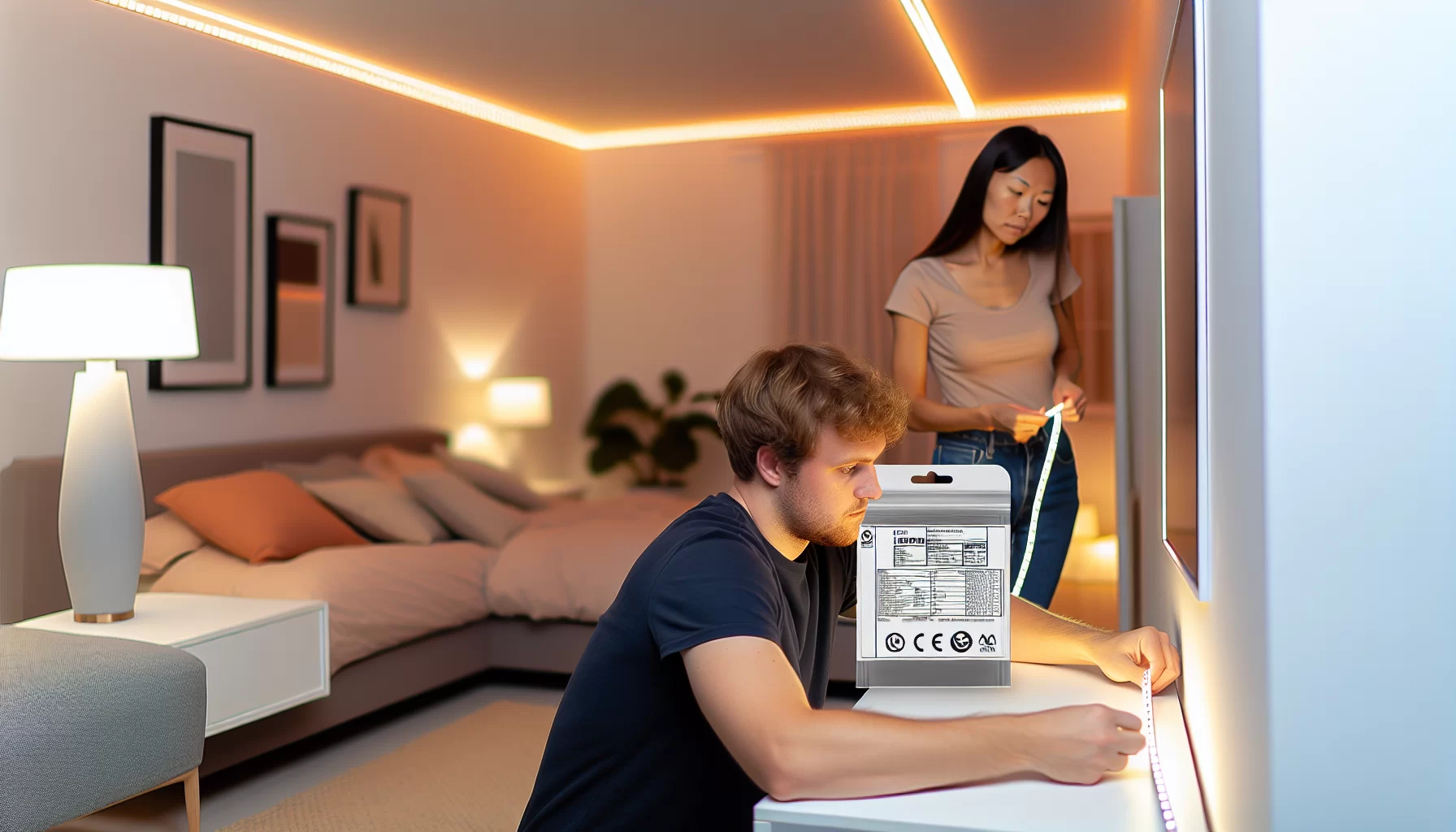
LED strip lights can be safely used in various areas of your home, from adding a cozy ambiance to your bedroom to providing practical illumination for your kitchen cabinets. However, each area of your home comes with its own set of considerations when it comes to the safe use of LED strip lights.
For instance, in bedrooms, the selection of LED strip lights and their effect on sleep quality is a key factor to consider. In the kitchen, the proximity to heat sources and adequate ventilation are crucial factors. Let’s explore these areas in a bit more detail.
Bedroom
In the sanctity of your bedroom, LED strip lights can create a soothing ambiance, contributing to a good night’s sleep. However, certain safety considerations are important. For instance, it’s essential to choose LED strip lights that operate at low-voltage, generate minimal heat, and are energy-efficient, such as Gosund smart led light strips, to ensure safety.
Moreover, LED strip lights can impact sleep quality due to the disruptive nature of blue light on sleep patterns. Therefore, it’s suggested to adjust the brightness, opt for warmer colors, and position the lights away from direct sight. This way, you can enjoy the beauty of LED strip lights without compromising your sleep.
Bathroom
Bathrooms can benefit greatly from the use of LED strip lights, offering bright, clear lighting for tasks like applying makeup or shaving. However, given the wet and humid environment, it’s important that the LED strip lights intended for use in a bathroom are waterproof or water-resistant and equipped with sufficient protection against moisture and splashes.
An IP65 rating indicates that the LED strip lights are resistant to water and their surfaces are safeguarded against water jets from all angles, making them appropriate for use in bathroom settings where moisture is prevalent. Moreover, LED strip lights should be installed away from shower areas to avoid water damage and ensure durability.
Kitchen and Cabinet Lighting
In the kitchen, LED strip lights can provide practical illumination for tasks like chopping and cooking. However, the proximity to heat sources and the need for proper ventilation are crucial considerations when installing LED strip lights in the kitchen.
Being exposed to high temperatures can diminish the lifespan and brightness of the LEDs, which may result in safety concerns. Therefore, it’s recommended to install LED strip lights in well-ventilated areas, like under cabinets and ceiling corners, to keep them cool during operation.
Tips for Prolonging the Lifespan and Safety of Your LED Strip Lights
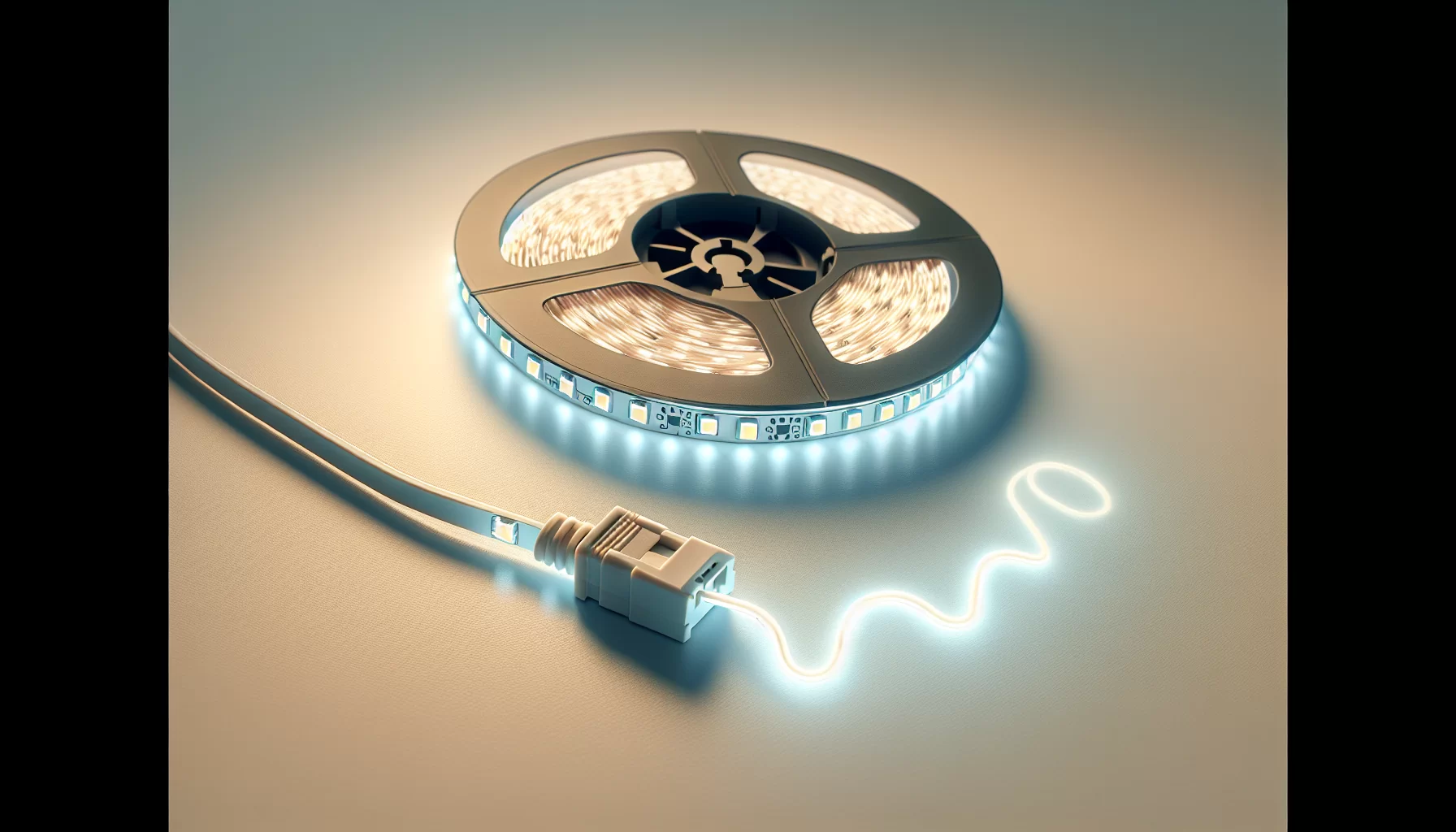
To extend the lifespan and safety of your LED strip lights, consider factors beyond their installation. These include choosing the right power supply, cutting and connecting them properly, and ensuring adequate ventilation and cooling.
Using the right power supply is essential to avert damage or malfunction of your LED strip lights. Additionally, LED strip lights can be cut to specific lengths if extended length of the strip features a designated cut line.
Moreover, it’s vital to ensure proper ventilation and cooling as it helps dissipate any heat produced by the lights, contributing to their peak performance and longevity.
Choosing the Right Power Supply
Selecting the appropriate power supply for your LED strip lights is crucial to their safety and performance. The power supply must align with the voltage requirements of the LED strip to avoid any damage or malfunction.
To assess compatibility, you need to consider the wattage and voltage. The output voltage of the power supply should align with the voltage of the LED strip lights, and the wattage should be adequate to power the LED strip lights. By choosing the right power supply, you can ensure the longevity and safe operation of your LED strip lights.
Proper Cutting and Connecting
When it comes to customizing your LED strip lights, take note that proper cutting and connecting techniques are crucial. LED strips generally feature indicators, such as dotted lines or sections with sets of copper pads, to signify safe cutting points.
Incorrect cutting of LED strip lights can lead to:
Circuit damage
Making parts of the strip unusable
Exposing wires
Compromising protection against moisture and dust
This can pose potential safety risks. By using the appropriate connectors and cutting techniques, you can customize your LED strip lights safely and efficiently.
Ventilation and Cooling
Lastly, it’s vital to ensure proper ventilation and cooling for your LED strip lights. Adequate ventilation aids in the dispersion of heat produced by the lights, thereby reducing the ambient temperature and preventing overheating.
Furthermore, heat sinks play a crucial role in dissipating heat from the LED strip and preventing overheating by dispersing it into the air. By considering these elements, you can ensure the optimal performance and longevity of your LED strip lights.
Summary
We’ve journeyed through the world of LED strip lights, delving into their safety features, potential risks, and the best practices for their installation and maintenance. From their inherent safety features such as low heat generation and energy efficiency to the safety aspects and the importance of selecting high-quality LED strips and proper installation, it’s clear that LED strip lights can be a safe and effective lighting solution when used correctly.
However, like any electrical appliance, they come with certain potential risks, including fire hazards, excessive blue light exposure, and overheating. By understanding these risks and how to mitigate them, you can embrace the brilliance of LED strip lights with peace of mind. Remember, the key to safe and effective use of LED strip lights lies in quality, correct installation, and regular maintenance.
Frequently Asked Questions
Are LED strip lights safe to use?
LED strip lights are safe to use, as they are designed to emit minimal heat and have protective silicon sleeves, making them safe to the touch. As long as proper precautions are taken, there should be no need to worry about safety concerns.
Is it okay to leave LED strip lights on all night?
Yes, it is generally safe to leave LED strip lights on overnight because they produce minimal heat and use less electricity, reducing the risk of safety hazards.
How do LED lights affect the human body?
LED lights can disrupt normal sleep patterns by delaying or inhibiting nocturnal melatonin production, affecting the quality of sleep. As people age, they may experience more difficulties with blue light sources.
Is it OK to have LED lights in your room?
Yes, it is perfectly safe to have LED lights in your room. LED lights are safe for regular, everyday use.
Do LED strips damage walls?
In conclusion, the main concern for wall damage with LED strips is not the lights themselves, but rather the adhesive used and the quality of the paint. Some tapes can cause paint damage or leave behind a sticky residue when removed.
Do RGB LED strips damage your eyes?
No, RGB LED strips do not damage your eyes if used properly. However, prolonged use and exposure to bright light can cause eye strain. It’s advised to adjust the brightness and color to a comfortable level.
Is it safe to leave an LED strip on constantly?
Yes, it is generally safe to leave an LED strip on constantly as they generate minimal heat. However, it is advisable to turn off when not in use to conserve energy and extend the lifespan of the strip.
Do LED lights damage paint?
LED lights themselves do not damage paint. However, the adhesive used to fix the LED strips can sometimes peel off the paint or leave a residue when removed.
Do LED lights take a while to get bright?
No, LED lights reach their full brightness almost instantly. Unlike traditional bulbs, they do not need time to warm up.
Do LED lights change paint color?
No, LED lights do not change the color of the paint. However, the color of the light can influence how the paint color appears to the eye.
Is LED lighting good for makeup?
Yes, LED lighting is excellent for makeup application as it provides clear, bright light. Choosing a LED light with a high color rendering index (CRI) will ensure accurate color representation.
Is it possible to convert an RGB LED to a white LED?
Yes, by mixing the red, green, and blue light in an RGB LED at full brightness, you can create white light. However, this may not be as pure or bright as a dedicated white LED.
Is it safe to use LED light strips to decorate a child’s room?
Yes, it is safe to use LED light strips in a child’s room. They do not heat up like traditional bulbs and are safe to touch. However, they should be installed out of reach of young children to prevent any potential hazards.
Is it safe to put LED lights on a metal bed frame?
Yes, it is safe to attach LED light strips to a metal bed frame. The LED strips produce minimal heat and are safe to touch. However, ensure that the adhesive used to attach the LED strips is strong enough to hold them securely, and the LED strips are waterproof if there’s a risk of exposure to liquids.
Is it safe to buy LED light strips from eBay?
Buying LED light strips from eBay can be safe, provided you do your due diligence. Check the seller’s ratings and reviews, and make sure the product has the necessary safety certifications. However, buying from a reputable, dedicated electronics or lighting retailer may provide more assurance in terms of product quality and after-sales support.
Is it safe to leave an LED strip on constantly?
Yes, it is generally safe to leave an LED strip on constantly as they generate minimal heat. However, it is advisable to turn off when not in use to conserve energy and extend the lifespan of the strip.

